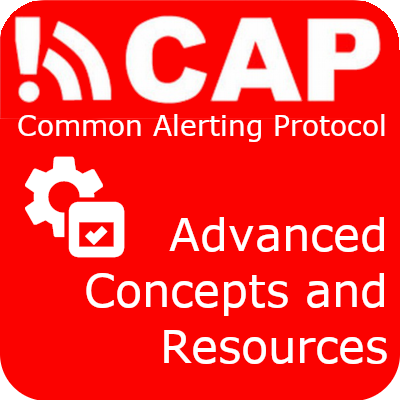Advanced CAP Concepts and Customization Resources
Perfilado de sección
-
 This collection of resources provides IT and communications staff guidance on setting up the software used for issuing CAP alerts and assuring that alerts meet CAP standards. As a collection of resources, this is a not a course, no badges or certificates of completion are issued.
This collection of resources provides IT and communications staff guidance on setting up the software used for issuing CAP alerts and assuring that alerts meet CAP standards. As a collection of resources, this is a not a course, no badges or certificates of completion are issued.-
Guidelines for implementing the technical components of the CAP standard. Also available in other languages here.
3.6 MB
-
These resources provide details on the XML structure of CAP messages. This information is critical for organizations developing or updating their own CAP alert authoring tools.
-
Eliot Christian's presentation on the XML structure of CAP messages.
3.8 MB -
This is the OASIS (Organization for the Advancement of Structured Information Standards) document defining CAP version 1.2. It details the XML structure and elements used for CAP alerts. Also available as HTML on the OASIS website.
567.3 KB -
A free service that checks the syntax of CAP XML messages and Atom, RSS and EDXL-DE feeds of CAP messages. It supports CAP v1.0, v1.1 and v1.2.
-
-
These resources pertain to creating a source of CAP alerts. Options here include writing alerts using a text authoring tool, modifying an existing alerting tool, hosting open source tools, or using an alert hosting service. Your situation and needs will dictate which resources to use.
-
This 36 minute presentation walks through the details of creating a CAP alert: authoring an alert file; hosting alert files; validation; security and authentication considerations; content considerations based on target media.
-
PowerPoint presentation used in Eliot's Christian's video presentation on implementing a source of CAP alerts.
1.5 MB -
This Task Analysis focuses on the tasks involved when an authorized person composes an alert message, tasks situated between the decision to alert and the dissemination of that alert. It addresses only alert composition tasks supported by online tools and only for the issuing of alerts online in the Common Alerting Protocol (CAP) format. The analysis is intended to inform development of well-designed tools for alert composition and so to help alert composers apply their expertise efficiently and effectively.
186.8 KB -
Eliot Christian's alert editing software. This is a Java-based tool for authoring and publishing CAP alerts to a CAP alert news feed.
-
137.4 KB
-
5.8 MB
-
9.7 MB
-
Github repository for CAPCreator, CAPCollector, CAPConsumer. This collection of tools is made available through an effort at Carnegie Mellon University.
-
Github repository for Filtered Alert Hub software.
-
This site provides a cloud-based platform for publishing CAP alerts. It is available to any country in need of a platform for publishing CAP alerts. As of March 2019, it is maintained by Eliot Christian through NOAA's Big Data Project.
-
The International Federation of Red Cross and Red Crescent Societies (IFRC) offers a suite of tools and templates for developing locally relevant alert apps.
-
-
Through the use of RSS or Atom syndication standards, CAP alerts are published and made available to their target audience. The following resources provide insight on using and creating CAP alert news feeds.
-
Eliot Christian's presentation on publishing a news feed. 17 minutes of the 29 minute presentation are highlighted here.
-
PowerPoint presentation used in Eliot's Christian's video presentation on publishing CAP alert news feeds.
929.5 KB -
This document provides guidance for dissemination of CAP alerts using RSS/Atom feeds.
197.2 KB
-
-
The following is a very small sampling of CAP alert technology leveraged for situational awareness. It is informative to explore these and other alerting tools to gather ideas for your own organizational needs.
-
A CAP alert aggregator of official warning and information issued by National Meteorological and Hydrological Services (NMHSs).
-
Examples Filtered Alert Hubs using the open source tools available through NOAA's Big Data Project.
-
Google aggregates CAP alerts from many international partners. Extensive information and guidance on participating is available here.
-
A comprehensive display of weather and CAP alerts. Developed by a passionate pilot for free reuse.
-
A CAP weather alert aggregator with feeds from many European Union meteorological services.
-
An CAP weather alert aggregator for Russia.
-
-
-
This document enables the registration of Object IDentifiers (OIDs) for alerting information, i.e., content included in alert messages or otherwise associated with the activity of alerting. The Registration Authority, World Meteorological Organization (WMO), maintains these OIDs and accepts requests through WMO Members for the assignment of additional OIDs for information objects relevant to alerting. This document specifies rules for the registration of all such OIDs subordinate to the alerting OID arc administered by WMO. Also available in other languages here.
220.6 KB -
The international Register of Alerting Authorities was set up by the World Meteorological Organization (WMO) and the International Telecommunication Union (ITU). Each WMO Permanent Representative (PR) maintains entries for their nation. The PR represents the entire nation and should register all nationally recognized alerting authorities. The Register is maintained by the WMO Public Weather Services Delivery (PWSD) programme.
-
